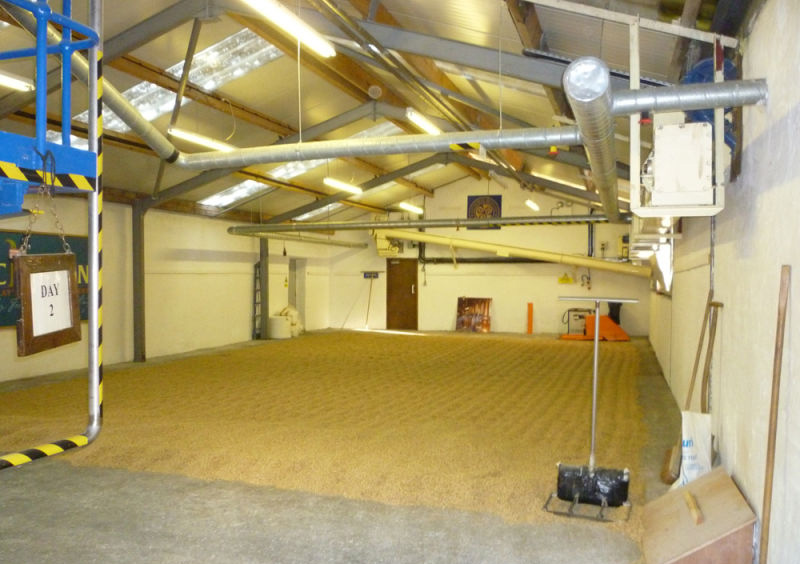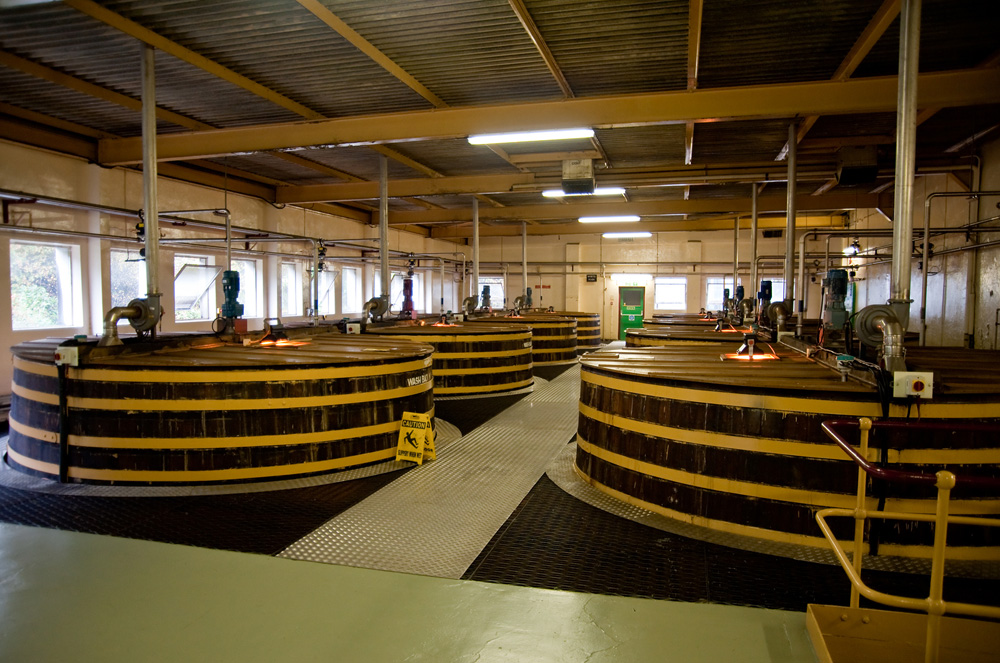Malting, Mashing and Fermentation
Whisky Production
Despite the variety of cereals and techniques, whisky production is quite similar worldwide. The main stages are: malting, mashing, fermentation, and distillation. This chapter will analyze the first three stages, while the distillation stage will be covered in the following chapter.
Malting
In Scotland, this is the first stage in the production of malt whisky, which involves the exclusive use of malted barley. Although whisky is also produced with unmalted grains in other countries, malted barley is still present in a certain percentage; in fact, the use of malted barley also aims to ensure efficient fermentation.
 Malting begins with soaking the barley in water, followed by germination. The barley is spread out in a well-ventilated warehouse with a floor made of concrete, stone, or tiles, in layers of about 50 cm. It starts to sprout (see the malt floor at Kilchoman); the sprout will penetrate the outer husk of the grains, making the enzymes and starches within accessible. After a few days, this process is halted by drying the barley, now called "green malt," over a heat source. On most of the Scottish islands, tradition dictates that the barley be dried using peat-fired heat; the smoke released imparts the characteristic smoky and peaty flavor to whiskies like Talisker, Caol Ila, Lagavulin, Ardbeg, and many others. The amount of peat varies depending on the desired level of peatiness (measured in phenols) to be imparted to the spirit. At this point, the malted barley is dry and is ground into a coarse flour called "grist."
Malting begins with soaking the barley in water, followed by germination. The barley is spread out in a well-ventilated warehouse with a floor made of concrete, stone, or tiles, in layers of about 50 cm. It starts to sprout (see the malt floor at Kilchoman); the sprout will penetrate the outer husk of the grains, making the enzymes and starches within accessible. After a few days, this process is halted by drying the barley, now called "green malt," over a heat source. On most of the Scottish islands, tradition dictates that the barley be dried using peat-fired heat; the smoke released imparts the characteristic smoky and peaty flavor to whiskies like Talisker, Caol Ila, Lagavulin, Ardbeg, and many others. The amount of peat varies depending on the desired level of peatiness (measured in phenols) to be imparted to the spirit. At this point, the malted barley is dry and is ground into a coarse flour called "grist."
Mashing
 The grist (milled malt) is mixed with hot water in specific metal containers called mash tuns. The "Lauter" mash tun is one of the most commonly used for mashing (see the one at Ardbeg), this stainless steel container is equipped with rotating arms that gently mix the grist and water mixture, known as "mash." Modern Lauter tuns continuously spray hot water into the mash tun; the water, at a temperature of about 65°/70°C, allows the enzymes in the barley to convert starches into sugars. The exhausted grain is separated from the liquid, which at this point is a dark, sugary, non-alcoholic liquid called "wort." As we will see, the next step in the process is fermentation, but first, the wort must pass through a heat exchanger to reduce its temperature (below 20°C). If the wort is too hot, the yeast used in fermentation might die too early, preventing it from completing its work.
The grist (milled malt) is mixed with hot water in specific metal containers called mash tuns. The "Lauter" mash tun is one of the most commonly used for mashing (see the one at Ardbeg), this stainless steel container is equipped with rotating arms that gently mix the grist and water mixture, known as "mash." Modern Lauter tuns continuously spray hot water into the mash tun; the water, at a temperature of about 65°/70°C, allows the enzymes in the barley to convert starches into sugars. The exhausted grain is separated from the liquid, which at this point is a dark, sugary, non-alcoholic liquid called "wort." As we will see, the next step in the process is fermentation, but first, the wort must pass through a heat exchanger to reduce its temperature (below 20°C). If the wort is too hot, the yeast used in fermentation might die too early, preventing it from completing its work.
The mashing procedure for unmalted cereals, such as corn, is slightly different from that of barley. In this case, the cereals are ground and cooked in a cylindrical tank or large pressure cooker. This procedure breaks down the cellulose walls of the grain and allows the starch to absorb water during the process. The starch then gelatinizes, enabling the enzymes in the grain to convert it into sugars.
Fermentation
 To begin fermentation, the wort is transferred to the washback, a large stainless steel container (many Scottish and Japanese distilleries still use traditional washbacks, typically made of larch or Oregon pine, see image). It is in the washback that yeast is added to start fermentation. The yeast consumes the starches in the wort, converting them into sugars, and then transforms these sugars into alcohol and carbon dioxide. At this point, the liquid is called "wash." During fermentation, the temperature of the wash rises to 35°C and bubbles vigorously, while a series of mechanical arms stir the surface to break up the foam and prevent overflow. After two or three days, the wort turns into beer, with an alcohol content ranging from 6% to 9% ABV. Unlike traditional beer produced in a brewery, which is processed in sterile environments, distillery beer is strong and pungent due to the presence of essential bacteria for whisky production.
To begin fermentation, the wort is transferred to the washback, a large stainless steel container (many Scottish and Japanese distilleries still use traditional washbacks, typically made of larch or Oregon pine, see image). It is in the washback that yeast is added to start fermentation. The yeast consumes the starches in the wort, converting them into sugars, and then transforms these sugars into alcohol and carbon dioxide. At this point, the liquid is called "wash." During fermentation, the temperature of the wash rises to 35°C and bubbles vigorously, while a series of mechanical arms stir the surface to break up the foam and prevent overflow. After two or three days, the wort turns into beer, with an alcohol content ranging from 6% to 9% ABV. Unlike traditional beer produced in a brewery, which is processed in sterile environments, distillery beer is strong and pungent due to the presence of essential bacteria for whisky production.
In many American distilleries, sour mash is used; this process involves pumping a certain amount of residue from the previous fermentation, called "backset" or "stillage," back into the washback to maintain the desired acidity level and facilitate the control of natural bacteria.
